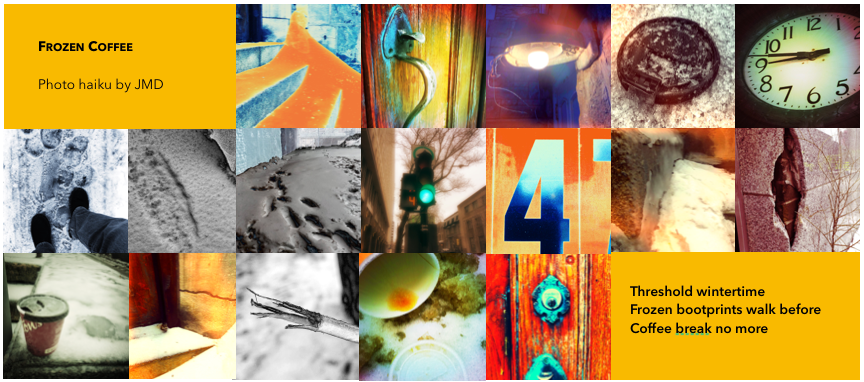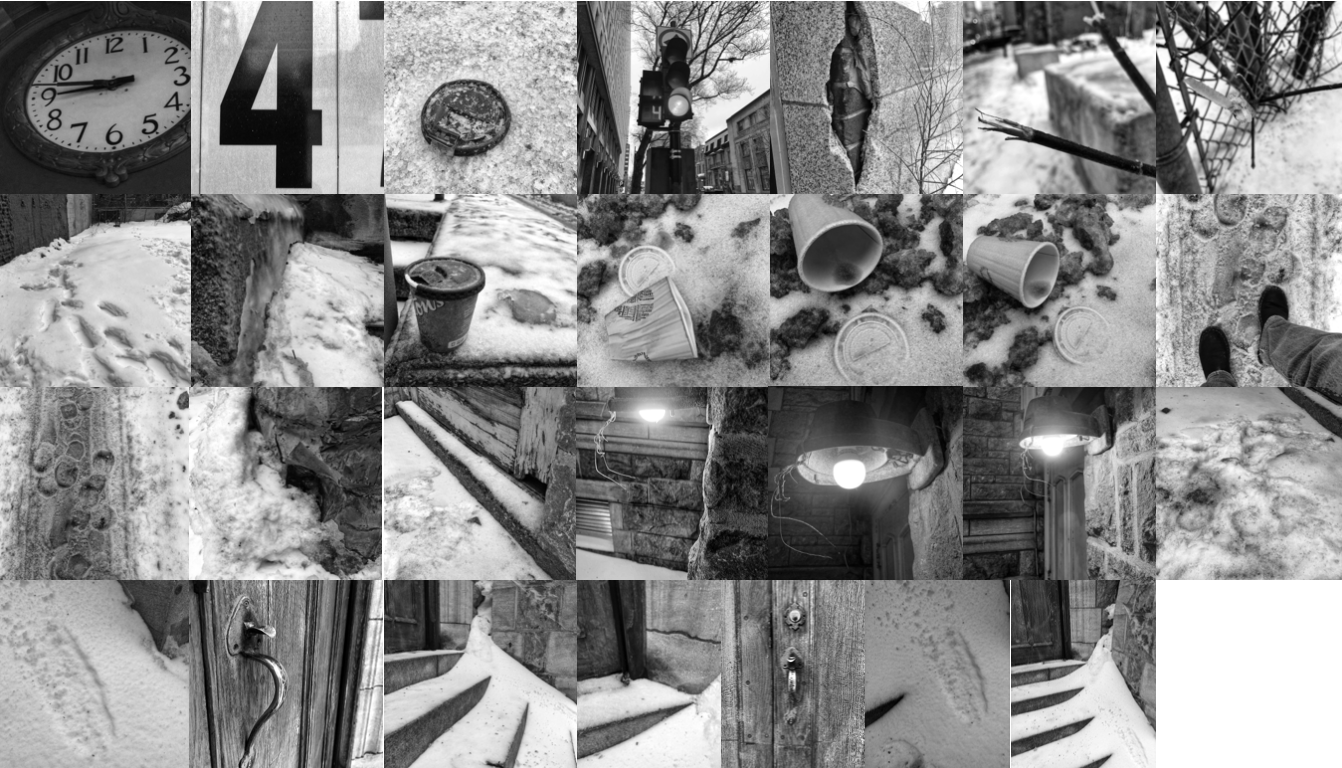
Jean-Marc Duchesne
Second year, Art education
Photo Haiku
LESSON PLAN
Students love to snap as many pics as their Smartphones will contain! The following lesson gets students to express, observe and manipulate the photographic plane in a creative and reflective process. The Haiku is traditional short written form of Japanese poetry—17 syllables arranged in three lines (5, 7, 5), while a Photo Haiku employs the same metered verse but uses images to compose a poetic representation.
Learning Objectives
Students will learn how to express themselves metaphorically and/or literally using a photo capturing device (Smartphone, iPad, DSLR). Learning how to set-up a shot (exposure triangle), how to choose interesting angles, isolating images that compose a scene, tell a story, or convey a feeling through a poetic narrative in 17 frames.
Materials
Process
A Haiku consists of the juxtaposition of two ideas. The prototype above combines: Wintertime and Coffee-break. Between these opposing ideas is a separation that acts as punctuation to emphasize, relate and connect elements to form a new idea. Seventeen (17) images arranged on three lines (5, 7, 5) create the Photo Haiku where images replace words. This project may be approached from various entry points—some prefer writing out their poem first, whilst others may choose to capture images that inspire the writing, and others still may just bypass writing and let their images speak.
| 1—Students are required to take a 20-minute timeframe at a pre-selected site or they may simply spend the time alone and upload images found over the Internet if they prefer not to go out. Here are some suggested settings and seasons: |
| Leaves blowing in the wind Wind sculpted snow First blossoms | Insects scrambling about A puddle as rain drops fall Snowflakes on a window sill | A garden patch A walk around the block An impenetrable doorway |
| On site or reflecting in silence, jot down phrases, words, or snap photos that inspire all the ideas that enter your mind. EXAMPLE: Along with written notes, I’ve also captured 27 pics (see below)— Walked over to a nearby church during a coffee break on a cold winter’s morning. Jotted ten successive observations at the church side entrance while sipping coffee and then walking through the back alley. |
frozen pile of snow
back alley walked
side doorway entrance
curved edges of white hard ice
dirty snow
bootprints in the snow
grey stone block wall
wood door and rusted doorknob
coffee break morning
litter: crushed coffee cup
winter morning
| 2—Back at the classroom, isolate those words or images that best captured the essence of place, feelings and/or thoughts: | EXAMPLE: Winter, Doorway, Bootprint, Cup, Frozen, Walk, Coffee break |
| 3—Put your word/images in a 5, 7, 5 order. There are many possibilities, so play and arrange them in all sorts of ways. | EXAMPLE: Threshold wintertime Frozen bootprints walk before Coffee break no more |
| 4— Once a student feels that the arranged images convey the intention, print the poem for appreciation, class critique and exhibition. | EXAMPLE: SEE PROTOTYPE |
Additional Ideas
I also like to teach the possibilities of photo manipulation by using different free smartphone apps, such as, Snapseed, Lens Distortions, Fused, Tadaa and Lightroom CC. See example above: “using photo manipulation.”
Consider creating a Video-Haiku where each video capture is edited as follows: 17 shots x 1 sec. = 17 sec. total, or a Soundscape-Haiku where only sounds are recorded and assembled.
| ACTIVITY PROCESS | TIME D-1 & 2: 2x45m or D-1: 1x90m | |
| Motivation | What is a haiku? (worksheet downloadable from scholastic.com) PDF LINK: http://teacher.scholastic.com/lessonplans/pdf/dec05_unit/whatishaiku.pdf Examples of photo haikus can be found on Internet to stimulate ideas. video LINK: https://www.youtube.com/watch?v=owfJ9Zxa-iU website LINK: https://www3.nhk.or.jp/nhkworld/en/tv/haiku_masters/gallery/?period=201811&category=photohaiku | 10 min. |
| Media exploration | For those students are versed about the exposure triangle, angles of view, light & shadow, and shot composition—they should apply the principals. If not, this assignment can become an entry point into photographic arts by getting students to think about shot value but just leaving settings on automatic. | 5 min. |
| Art-making Procedure | Learners will capture images at a prior selected location. NOTE: it is important that this be done individually or at most paired. As they snap photos (more than 17) very quickly, they should also jot down phrases and words that the location inspires. Students upload on iPad and/or print the images to be arranged numerically and/or glued in a 5, 7, 5 order. | 20 min. *Break here to carry over onto Day-2 25 min. |
| Response | As a group, students will display and share their art. Here are a few questions to direct the conversation: What did you consider first? Which images do you prefer and why? How does the sum of images convey the overall idea/emotion? How are you creating intention through photo arrangement and shot value? | 30 min. |
| Studio etiquette | All photo capturing devices fully charged. Note pads and pencils made available. At the teacher’s desk a computer or iPads and a printer. A way to drop images will be determined: USB key, dropbox, class email, etc. Display boards to showcase | Teacher Prep. 10 min. |
Figures:

